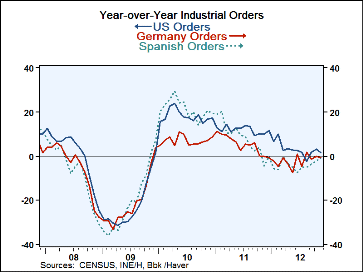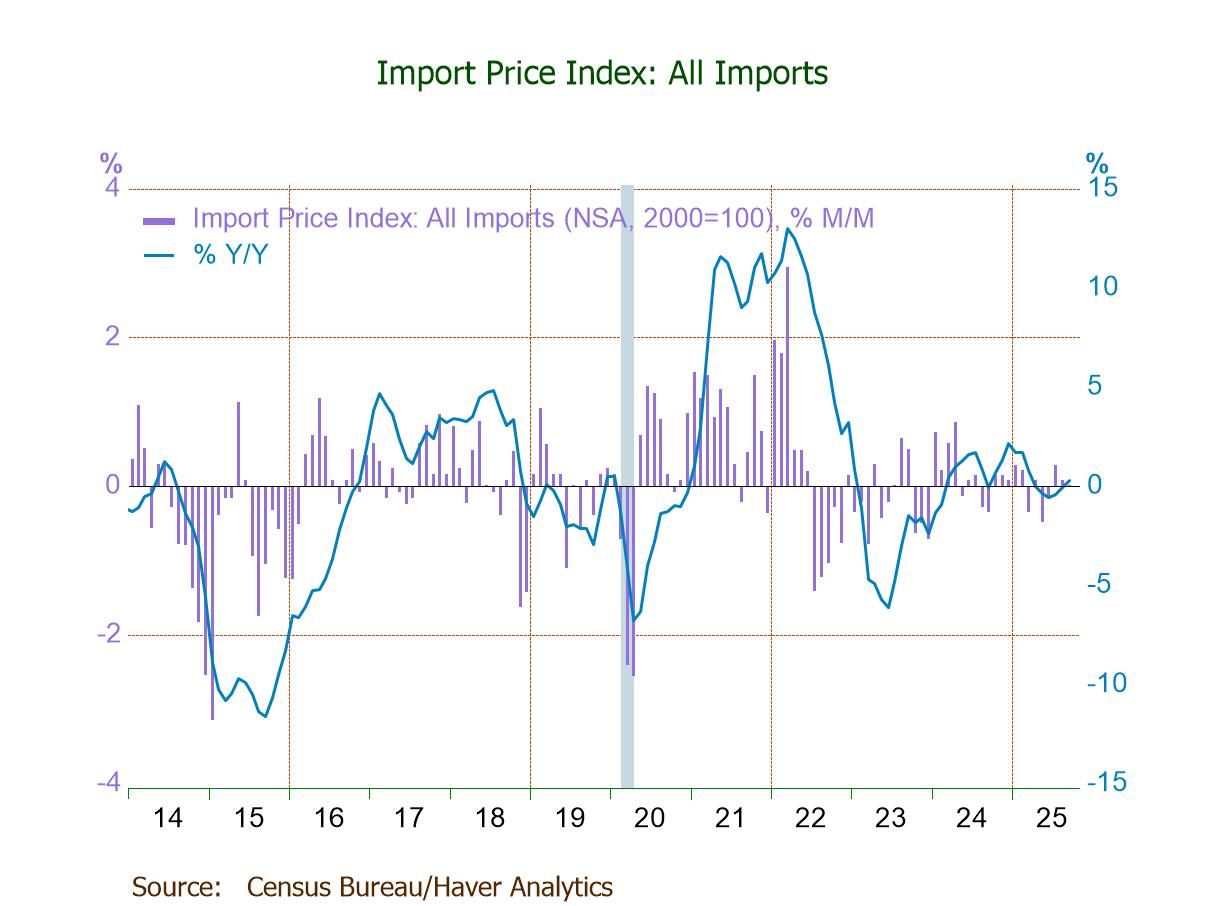 Global| Jan 18 2013
Global| Jan 18 2013European Orders Continue to Drop
Summary
European manufacturing continues to weaken. The 12 month percentage change in orders is substantially lower for all the countries listed in the table than it was at this time one year ago. . When we compare the year-over-year [...]
 European manufacturing continues to weaken. The 12 month percentage change in orders is substantially lower for all the countries listed in the table than it was at this time one year ago. . When we compare the year-over-year percentage change in orders for the year ended November 11 to November 10 the drop is substantial. The difference in the two rates of growth is on the order of 20 percentage points lower for countries in this table. Over shorter horizons the decline in order momentum is just as dramatic and just as clear-cut: over three months the growth rate is weaker for all the European countries the table that present seasonally adjusted data except Germany where a 6% six-month drop has been reduced to a 4% annual rate drop over three months. Portugal has managed to keep order growth steady at 2.6%. In sharp contrast the US shows a surge in orders over three months compared to six months but its data have some weather-related issues for this period.
European manufacturing continues to weaken. The 12 month percentage change in orders is substantially lower for all the countries listed in the table than it was at this time one year ago. . When we compare the year-over-year percentage change in orders for the year ended November 11 to November 10 the drop is substantial. The difference in the two rates of growth is on the order of 20 percentage points lower for countries in this table. Over shorter horizons the decline in order momentum is just as dramatic and just as clear-cut: over three months the growth rate is weaker for all the European countries the table that present seasonally adjusted data except Germany where a 6% six-month drop has been reduced to a 4% annual rate drop over three months. Portugal has managed to keep order growth steady at 2.6%. In sharp contrast the US shows a surge in orders over three months compared to six months but its data have some weather-related issues for this period.
In the month of November among the large emu countries only France has an increase in order month-to-month. Germany posted 2.6% annual rate decline Italy poses 0.5% decline in Spain a 1.3% decline. In the periphery Portugal shows a 3.3% rise. The Netherlands also shows a rise of 2.9%. But by and large, Euro zone continues to demonstrate that it slowing down.
If we look to see how these countries are doing in the context of the current business cycle, Germany and the Netherlands post order levels that are only 11% below their respective past cycle peaks. Italy and Spain and Portugal are closer to 25% below their cycle peaks. France is still below its peak by about 20%.
The quarter to date is marked by declines in Italy, Spain and Portugal. Germany and France are both showing moderate increases in orders (2% to 4%) as of November taking the percentage change over the base of the third quarter. In the Netherlands orders are currently flat with their third quarter level.
The picture gleaned from three month percentage changes in orders is that Europe is still slowing down; in some cases slowing down rather rapidly. However, the quarter-to-date framework which looks at three-month averages over specific quarterly periods is a little bit less dire in its assessment, seeing the weakness as still more concentrated in the peripheral countries. Needless to say circumstances in the zone remain in flux we continue to see weakness in orders and in output with exports weakening pretty much across the board. The purchasing manager framework shows that the slippage on the industrial side is losing pace and that's good news... but the bad news is that the slippage is still there.
| E-Zone EU US Industrial Orders & Sales Trends | |||||||||
|---|---|---|---|---|---|---|---|---|---|
| SAAR ex. pt M/M | % M/M | Nov 2012 |
Nov 2012 |
Nov 2012 |
Nov 2011 |
Nov 2010 |
Q-to-Date | ||
| Ezone Detail | Nov 2012 |
Oct 2012 |
Sep 2012 |
3-Mo | 6-Mo | 12-Mo | 12-Mo | 12-Mo | SAAR |
| Germany | -2.6% | 3.7% | -2.0% | -4.1% | -6.0% | -0.1% | -2.8% | 24.9% | 3.8% |
| France | 0.4% | 1.1% | -2.5% | -4.0% | 0.4% | 0.9% | -0.7% | 19.7% | 2.3% |
| Italy | -0.5% | 0.1% | -4.1% | -16.7% | -7.1% | -6.5% | -0.1% | 11.2% | -12.5% |
| Spain | -1.3% | -1.3% | -3.3% | -21.0% | 6.6% | -0.8% | -0.2% | 7.0% | -7.2% |
| Portugal | 3.3% | -11.2% | 9.7% | 2.6% | 2.6% | -6.3% | -22.7% | 49.8% | -14.2% |
| Finland (NSA) |
8.6% | 6.5% | 5.9% | 125.2% | 21.5% | 2.2% | 1.2% | 21.7% | 135.8% |
| The Netherlands | 2.9% | -4.7% | -0.9% | -11.0% | 0.5% | 3.0% | -3.4% | 12.7% | 0.0% |
| US Factory Orders | 0.0% | 0.8% | 4.5% | 23.2% | -0.2% | 4.2% | 5.1% | 1.3% | 9.8% |
Robert Brusca
AuthorMore in Author Profile »Robert A. Brusca is Chief Economist of Fact and Opinion Economics, a consulting firm he founded in Manhattan. He has been an economist on Wall Street for over 25 years. He has visited central banking and large institutional clients in over 30 countries in his career as an economist. Mr. Brusca was a Divisional Research Chief at the Federal Reserve Bank of NY (Chief of the International Financial markets Division), a Fed Watcher at Irving Trust and Chief Economist at Nikko Securities International. He is widely quoted and appears in various media. Mr. Brusca holds an MA and Ph.D. in economics from Michigan State University and a BA in Economics from the University of Michigan. His research pursues his strong interests in non aligned policy economics as well as international economics. FAO Economics’ research targets investors to assist them in making better investment decisions in stocks, bonds and in a variety of international assets. The company does not manage money and has no conflicts in giving economic advice.






